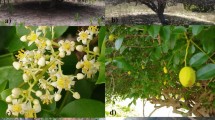Abstract
Apart from the wild species P. orientalis and P. occidentalis, the cultivated plane trees constitute a wide and heterogeneous group, with uncertain genetic status and largely debated names. The recent canker stain problem in Europe makes it necessary at the present time to consider the genetic resources and to determine the genetic bases of all these trees. To attain this objective, a genetic molecular approach was used to analyze 60 trees of P. orientalis and P. occidentalis,different London planes (P. hispanicaand P. densicoma), a few controlledP. occidentalis × P. orientalishybrids and particular trees from arboreta and old parks. Molecular analysis involved thirty RAPD fragments generated with nine primers, PCR-RFLP in the 5S RNA genes and mitochondrial polymorphisms revealed by RFLP method. Clones were recognized amongP. hispanica and P. densicomatrees. A Correspondence Analysis and a dendrogram constructed according to the genetic distances confirmed the supposed hybrid origin of P. hispanica and P. densicoma between P. occidentalisand P. orientalis. Contribution ofP. orientalis to their constitution seems more important than that of P. occidentalis. Mitochondrial DNA polymorphisms indicated that crosses occurred in both directions. Moreover, P. occidentalis as female parent led toP. densicoma whereas P. orientalis as female parent led to P. hispanica. Low prevalence of pure species individuals and confusion risks with hybrid trees even for old trees are highlighted.
Similar content being viewed by others
References
Anselmi, N., L. Cardin & G. Nicolotti, 1994. Plane decline in European and Mediterranean countries: associated pests and their interactions. Bull EPPO 24: 159–171.
Bean, W.J., 1976. Trees and Shrubs Hardy in the British Isles. 8th Edn Vol. 3., pp. 263–277.
Benzécri, J.P., 1973. L'Analyse des Données. Tome I. La Taxonomie. Eds Dunod, Paris.
Besnard, G., P.S. Green & A. Bervillé, 2002. The genus Olea: molecular approach of its structure and relationships to other Oleaceae. Acta Botanica Gallica 149: in press.
Dawson, I.K., A.J. Simons, R. Waugh & W. Powell, 1996. Detection and pattern of interspecific hybridization between Gliricidia sepium and G. maculata in Meso-America revealed by PCR-based assays. Mol Ecol 5: 89–98.
Dewey, R.E. & D.H. Tymothy, 1986. Novel recombinations in the maize mitochondrial genome produce an unique transcriptional unit in the Texas male-sterile cytoplasm. Cell 44: 439–449.
Dode, L.A., 1908. Notes dendrologiques: sur les platanes. Bulletin de la Société Dendrologique de France 7: 27–68.
Gentzbittel, L., G. Zhang, F. Vear, A. Bervillé & P. Nicolas, 1995. Development of a consensus linkage RFLP map of cultivated sunflower (Helianthus annuus L.). Theor Appl Genet 90: 1075–1084.
Henry, A. & M.G. Flood, 1919. The history of the London plane (Platanus acerifolia). Notes on the genus Platanus. Proc Royal Irish Academy 35: 9–28.
Hooker, W.S., 1856: Occidental plane. Gard Chron April, 23, pp. 282.
Hsiao, J.Y. & H.L. Li, 1975. A study of the leaf chromatograms of the London Plane and its putative parent species. Amer Midl Natur 93: 234–239.
Huntley, B. & T. Webb, 1989. Migration: species' response to climatic variations caused by changes in the earth's orbit. J Biogeography 16: 5–19.
Jaccard, P., 1908. Nouvelles recherches sur la distribution florale. Bull Soc Vaud Sci Nat 44: 223–270.
Jeandroz, S., P. Faivre-Rampant, A. Pugin, J. Bousquet & A. Bervillé, 1995. Organization of nuclear ribosomal DNA and species-specific polymorphism in closely related Fraxinus excelsior and F. oxyphylla. Theor Appl Genet 91: 885–892.
Jeandroz, S., N. Frascaria-Lacoste & J. Bousquet, 1997. Molecular recognition of the closely related Fraxinus excelsior and F. oxyphylla (Oleaceae) by RAPD markers. For Genet 3: 237–242.
Loudon, J.C., 1854. Arboretum et fruticetum Britanicum. 2nd. edn., In chap. CVII, pp. 2032-2048.
Nei, M., 1987. Molecular Evolutionary Genetics. New York Columbia University Press, New York.
Quillet, M.C., N. Madjidian, Y. Griveau, H. Serieys, M. Tersac, M. Lorieux & A. Bervillé, 1995. Mapping genetic factors controlling pollen viability in an interspecific cross in Helianthus sect. Helianthus. Theor Appl Genet 91: 1195–1202.
Rivals, P., 1979. Sur la croissance, la morphologie, la sexualité et l'identification des platanes eurasiatiques. Travaux du laboratoire forestier de Toulouse 3: 1–70.
Rieseberg, L.H., B. Sinervo, C.R. linder, M.C. Ungerer & D.M. Arias, 1996. Role of gene interactions in hybrid speciation: Evidence from ancient and experimental hybrids. Science 272: 741–744.
Santamour, F.S., 1970. Hybrid vigour in seedlings of re-created London plane. Nature 225: 1159–1160.
Santamour, F.S., 1972. Interspecific hybridization in Platanus. Forest Science 18: 236–239.
Santamour, F.S. & A.J. McArdle, 1986. Check list of cultivated Platanus (plane tree). J Arboric 12: 78–83.
Saporta, G., 1990. Probabilités, Analyse des données et Statistique. edn. TECHNIP, Paris, 493 pp.
SAS Institute, 1992. SAS/STAT Language Guide for Personal Computers. Release 6.03. Edn. SAS Inst., Cary, NC, USA.
Stebbins, G.L., 1950. Variation and Evolution in Plants. Colombia University Press, New York.
Vigouroux, A., 1992. Preliminary results for obtaining a plane tree resistant to canker stain and adapted to European conditions. Acta Hort 320: 91–96.
Vigouroux, A., G. Besnard, K. Sossey-Alaoui, M. Tersac & A. Bervillé, 1997. Le statut d'hybride de Platanus acerifolia con-firmé et celui de P. densicoma mis en évidence à l'aide de marqueurs génétiques moléculaires; conséquences. Acta Botanica Gallica 144: 243–251.
Walter, J.M., 1946. Canker Stain of Plane Tree. US Dept Agri Cire. 742 pp.
Wang, W.Y., R.C. Pai, C.C. Lai & T.P. Tin, 1994. Molecular evidence for the hybrid origin of Paulownia taiwaniana based on RAPD markers and RFLP of chloroplast DNA. Theor Appl Genet 89: 271–275.
Author information
Authors and Affiliations
Rights and permissions
About this article
Cite this article
Besnard, G., Tagmount, A., Baradat, P. et al. Molecular approach of genetic affinities between wild and ornamental Platanus . Euphytica 126, 401–412 (2002). https://doi.org/10.1023/A:1019912425987
Issue Date:
DOI: https://doi.org/10.1023/A:1019912425987




